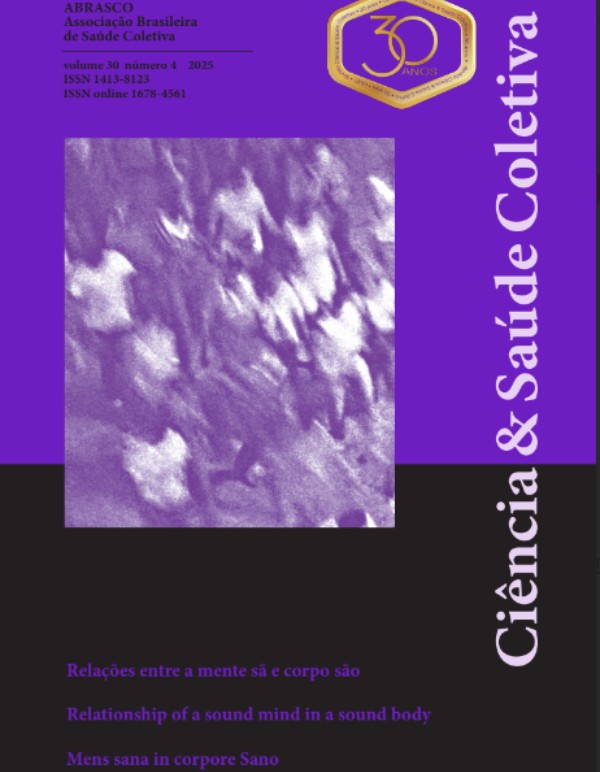Resumo (abstract):
The objective of the study was to evaluate the length of stay in pediatric hospitalizations for acute viral bronchiolitis in the Brazilian Health System (SUS) and the costs of hospitalizations. This was a quantitative, observational, and ecological study, based on a retrospective and longitudinal analysis of datathe Department of Informatics of the Unified Health System (DATASUS; 2012-2021) using descriptive statistics and Tukey\'s paired test. Regarding the mean value of AIH/HAA Hospital Admission Authorization, among the regions, the high costs of hospitalizations are located more frequent in the Southeast region and the lowest proportion is directed to the corresponds to the North region. In the length of hospital stay among the regions, the shortest mean stay was identified in the Central West region (2.5 days) and the greatest stay in the Northeast region (3.1 days). Considering the age group of one year of life, its representativeness was 57% when compared to the age group of 1-4 years (43%). Although gaps are observed in the Health System, the management of bronchiolitis prevention in children in primary health reflects the low effectiveness of investment in the health system, impacting the increase in demands for hospital admissions.
Palavras-chave (keywords):
Acute Viral Bronchiolitis, Health Information Systems, Hospitalization, Hospital Costs, Unified Health System.
Ler versão inglês (english version)
Conteúdo (article):
Acute Viral Bronchiolitis in Brazil: Length of stay and hospital costs
Simone Isidoro Prado 1
https://orcid.org/0000-0002-1685-4102
Maykon Anderson Pires de Novais 1.,2
https://orcid.org/0000-0001-8069-4927
Abstract: The objective of this study was to evaluate the length of stay and hospitalization costs for children with acute viral bronchiolitis in the Brazilian Health System (SUS). This was a quantitative, observational and ecological study based on a retrospective and longitudinal analysis of data from the Department of Informatics of the Unified Health System (DATASUS; 2012--2021) that employed descriptive statistics and Tukey\'s paired test. Hospitals in the Southeast region had the highest average authorized hospital admission (AHA) costs, while those in the North region tended to have the lowest average costs. Regarding the length of hospital stay between the regions, the shortest mean stay was identified in the Midwest region (2.5 days), and the longest was in the Northeast region (3.1 days). One-year-old patients constituted 57% of the cohort, while children aged 1-4 years accounted for 43%. Although gaps were observed in the health system, management of the prevention of bronchiolitis in children in primary health care reflects the low effectiveness of investment in the health system, resulting in increases in admission demands and related expenses.
Keywords: Acute Viral Bronchiolitis, Health Information Systems, Hospitalization, Hospital Costs, Unified Health System
Abstract: The objective of this study was to evaluate the length of stay in pediatric hospitalizations for acute viral bronchiolitis in the Brazilian Health System (SUS) and the cost of hospitalization. This was a quantitative, observational, and ecological study based on a retrospective and longitudinal analysis of data from the Department of Informatics of the Unified Health System (DATASUS; 2012--2021) conducted via descriptive statistics and Tukey\'s paired test. Among the regions, the highest average authorized hospital admission (AHA) costs were observed most frequently in hospitals in the Southeast region, while the lowest costs were observed in hospitals in the North region. In terms of the length of hospital stay among the regions, the shortest mean stay was identified in the Central West region (2.5 days), and the greatest stay was in the Northeast region (3.1 days). A total of 57% of the patients were in the 1-year age group, while 43% were in the 1-4-year age group. Although gaps were observed in the Health System, the management of bronchiolitis prevention in children in primary health care reflects the low effectiveness of investment in the health system, resulting in an increase in demands for hospital admission.
Keywords: Acute Viral Bronchiolitis, Health Information Systems, Hospitalization, Hospital Costs, Unified Health System
Introduction
Acute viral bronchiolitis (AVB) has a substantial incidence in the first years of life and is mainly caused by infectious processes due to respiratory syncytial virus (RSV) in the lower respiratory tract in children under 2 years of age. This disease is considered the main cause of the increase in hospital admissions in Brazil for children under the age of 2 years given its high incidence in this age group. (1.2)
Climatic variability also affects the number of cases of AVB associated with RSV. In some regions with temperate climates, infections occur in predictable annual outbreaks lasting 4–6 months (from late October to early spring), which varies by country, region or state. (3,4,5,8)
The climate profiles of many regions are relevant given the increase in pediatric hospitalizations during certain seasons of the year, as well as the general demands for pediatric care and waits in emergency care units that can be observed in the hospital setting.
The evident demands on health, associated with the worsening of cases of AVB in certain seasons, have led to wide discussions and high variability regarding the need for the health system to provide equitable, universal strategies and policies that meet the demands of the socioeconomic profile of each individual (infants and children), as this worsening is already expected in all national and international regions.
Approximately 0.5–2.0% of (previously healthy) infants infected with RSV require hospitalization, and approximately 0.5–1.0% of them will be admitted to an intensive care unit under mechanical ventilation. AVB results in an average of 3–4 million hospitalizations/year. In the USA, admission expenses for AVB in children under two years of age exceeded 1.7 billion dollars in 2009; in 2003, the highest hospitalization rates were seen for children aged 30-60 days, 29.0% of whom required hospital admission, representing an annual expenditure of 50.5 million dollars and admission costs of 650 million dollars. (6,7,9,11)
Importantly, AVB represents a significant number of visits to pediatric emergency units for patients under two years of age and may be associated with unwanted clinical outcomes, a high incidence of mortality and a greater number of hospital admissions nationally and internationally. (19.20)
Length of stay is dependent on a number of comorbidity-associated variables, such as the presence of acute conditions at hospital admission; for example, lengths of hospital stay ranging from 2.68 to 4.0 days have been reported for patients in whom clinical worsening was not observed during admission. (20.21)
The impacts of hospital expenses due to AVB are associated with several factors, such as the presence of comorbidities; clinical deterioration; and the application of therapeutic approaches such as inhalation oxygen and invasive and drug therapies such as corticosteroids and antibiotics, with an approximate annual direct cost of US$394 million. (10)
As pediatric comorbidities and external factors can impact the clinical course of AVB and its prognosis, they will have a great impact on hospital hospitalization costs and the length of stay.
Therefore, the objective of this study was to evaluate the length of stay for pediatric patients admitted for AVB in the Brazilian Health System (SUS) and the corresponding admission costs in each macroregion in Brazil from 2012-2021.
Methods
This quantitative, observational and ecological study was based on a retrospective and longitudinal analysis of data from the Department of Informatics of the Unified Health System (DATASUS).
The study design was guided by the Strengthening the Reporting of Observational Studies in Epidemiology (STROBE) tool. This checklist makes essential recommendations to authors to ensure the transparency and breadth of publications in observational studies. It consists of 22 items of specific recommendations for elaborations and essential topics in each section of the study with the designs included in the tool.(24)
For national data, the Hospital Information System (HIS-SUS) was used. Data collection was performed on the DATASUS website by accessing the “Health Care”, “Health Care Network” and “Epidemiology and Morbidity” directories section of the “Health Information - TabNet” section, which allows access to no clinical data but only hospitalization data that can be stratified by age group and site of care. As this platform has open access, it was possible to access information on the number of admissions in the public health system.
The population consisted of pediatric patients aged less than one year or 1-4 years according to data from the information system available on DATASUS. Data were collected for the entire period from 2012 to 2021.
Data was automatically extracted by developing a Java application connected via the HTTP protocol with the hospital (HIS) and outpatient (OIS) output tables of TABNET/DATASUS. For both the HIS and OIS, the temporary internal identification numbers were searched manually.
Through a loop involving the collection period and procedure of interest, a POST request was made to the address http://tabnet.datasus.gov.br/cgi/tabcgi.exe, containing arguments for output (OIS or HIS), table type ("Brazil by Region and Federation Unit"), row ("Year/month of service"), column ("Region"), increment, year, month and procedure and format (table). For each procedure, three (HIS) or two (OIS) requests were made for each increment.
For each request, the DATASUS TABNET server returned an HTML file containing the tabulated data. Each file was then parsed by the application, which extracted each data point from the table and saved it in an array containing the values of interest.
At the end of the table analysis, the array was saved in a string variable prepared in CSV format. After going through all the years of the search, the application exported the CSVs containing all the data to a single file. Simultaneously, the data were entered in duplicate by independent researchers into statistical and descriptive analysis software. Any discrepancies were then reviewed and corrected.
The data (response variables: average cost of hospitalizations, length of hospital stay and age group per macroregion) were summarized with descriptive statistics (mean, standard deviation, sums, minimum value, maximum value and median) according to year and region (independent variables).
The data were tabulated in a spreadsheet and transferred to Minitab statistical software (v. 18.1). To obtain the results of the statistical analyses, a statistical significance level of p ≤0.05 was adopted. For each response variable, the impact of the four independent variables was assessed with an analysis of variance model, considering the four independent variables as well as the interaction effect between “Year” and “Region” (indicated by “Year*Region”).
In the case of statistical significance (for the interaction factor or any other individual factor), Tukey\'s method for multiple comparisons and the corresponding 95% confidence intervals were used to identify the levels of the factor with significant differences between them.
On the basis of the results obtained in terms of the length of stay by macroregion, age group and mean value of admissions for AVB at the national level, the epidemiological information was analyzed according to the classifiers available in DATASUS.
Results
Statistical analysis of independent variables such as length of stay by macroregion and the mean value of authorized hospital admissions (AHAs) from the DATASUS information system (2012-2021), pediatric patients admitted to the hospital for respiratory system diseases (ICD21 includes the diagnosis of acute bronchiolitis) had highly variable demographic characteristics across the regions evaluated in this study.
A statistically significant difference was observed in the average costs of AHAs between regions over the years (p = 0.017), but correction for multiple comparisons with Tukey\'s test revealed no significant difference between 2 consecutive years between 2020 and 2021 or in the average cost of admission by region.
According to the regional distribution of mean admission costs for acute bronchiolitis, higher values were observed in the Southeast region and lower values were observed in the North region (mean hospitalization cost R$ 2,934.40). ANOVA revealed a statistically significant difference (p = 0.017) in the average costs of authorized admissions among the regions from 2012-2021 (Table 1).
Table 1. Synthesis of Data from the Macroregions of Brazil.
When the length of stay for AVB was analyzed, the results indicated a significant difference (p<0.001) in the mean value, in line with the significantly different number of admissions over the years. In treating AVB, the shortest length of stay was observed in the Midwest region (2.5 days), and the longest was observed in the Northeast region (3.1 days), but the difference was not significant (Table 2).
In terms of age group, the days spent admitted to the hospital tended to be predominated by pediatric patients younger than one year of age (57.0% versus 43% for patients between 1 and 4 years of age); the difference was statistically significant (p <0.001). In some regions, admission periods of 6-9 days were identified, highlighting regional differences.
Discussion
In this ecological study, the main finding was the variability in admission costs for pediatric patients diagnosed with AVB among macroregions of Brazil, which may be associated with comorbidities and clinical deterioration at admission or during hospitalization.
Acute bronchiolitis is included in the context of Hospitalizations for Primary Care-Sensitive Conditions (HPCSCs), reinforcing the need to implement public policies to reduce diseases and the costs of hospital admission and stay.
Among the acute respiratory syndromes affecting the lower respiratory tract, bronchiolitis continues to be responsible for many hospitalizations in infants. In developing countries, the number of deaths due to AVB has been decreasing. However, children with comorbidities, such as immunodeficiency and chronic lung diseases or congenital heart disease, have more severe conditions, increasing the lethality of the disease. (11-13)
Studies conducted to improve the performance of child health indicators and pediatric hospitalization rates have shown that respiratory diseases are responsible for high rates of hospitalization in children under five years of age. (18)
Regarding aspects associated with hospital morbidity in children under five years of age and the main causes of pediatric hospitalization, studies have shown that respiratory diseases are related to both, although several pathologies affect pediatric health. Among 342 pediatric patients admitted to the hospital, 217 were diagnosed with diseases of the respiratory system. (18)
The data on the pediatric population younger than five years of age included in the present study are in accordance with those observed in the literature. Between 2012 and 2021, certain macroregions, such as the South region (median: 474), had fewer hospital admissions for pediatric patients than did the Southeast Region (median: 1,978).
Additionally, the significant increase in hospitalizations for bronchiolitis at the national level observed in this study can be compared with that reported in the literature. This increase is notable in that the 10-year period overlapped with the COVID-19 pandemic, in which restrictions of social isolation resulted in a reduction in the number of hospitalizations at both the national and international levels.
The variables evaluated in the present study agree with those of a study conducted at the national level in 2020 assessing the impact of the COVID-19 pandemic on pediatric admissions, which revealed a reduction of more than 70.0% for infants under one year of age with AVB throughout the country. (18)
We also observed an increase in hospital expenses before the pandemic in children under four years of age among the regions evaluated in the study.
However, the international literature reports estimated expenditures of up to 545 million dollars in the United States and that approximately 34 million new cases are diagnosed worldwide. (14,15,16,17)
Regarding the mean length of hospital stay, hospital expenses and age groups, the findings in the present study are similar to those reported in the literature, with a mean hospitalization time of 6 days for the respective diseases.
A retrospective cross-sectional study was conducted involving 71 patients with a hospitalization time of 4–6 days and an admission diagnosis of AVB, revealing a high incidence of the disease, a short length of stay and a low mortality rate. (22.23)
The present study agrees with the literature in that the highest incidence of AVB was observed in pediatric patients younger than one year of age. (21)
A mean hospital stay of 2.5–3.1 days for patients with AVB was reported in this study.
Regarding the length of stay and hospital expenses for patients with bronchiolitis, our evidence obtained is similar to that of retrospective studies (22,23), which indicated an increase in admissions for the disease in infants under one year of age and equivalent expenses associated with the demands of hospital resources and disease treatment during hospitalization.
Conclusion
The increased number of admissions for cases of acute viral bronchiolitis in infants younger than one year of age emphasizes the need to consolidate interventions to reduce them.
The greater length of stay for acute viral bronchiolitis observed in the Southeast and Northeast regions reinforces the need to implement public policies for the early identification of cases of bronchiolitis in these regions, as late recognition of the disease can increase the length of stay and therefore hospital expenses.
This nationwide study could serve as a reference for alerting the implementation of public policies to promote the health of infants and children through preventive actions at home and directives aimed at reducing the incidence of the disease, the length of stay and hospital expenses.
References
1. Del Toro Rodríguez Liliam Beatriz, Martínez Benítez Iliana, Martínez Morales Iselis, Garcia Aguilera Ania, Diéguez Avid Maria Andrea. Caracterização clínico-epidemiológica da bronquiolite em pacientes pediátricos. Multimed [Internet]. 2021 de Abril, 25 (2): e1448.
2. Tan, J., Wu, J., Jiang, W. et al. Etiology, clinical characteristics and coinfection status of bronchiolitis in Suzhou. BMC Infect Dis 21, 135 (2021). https://doi.org/10.1186/s12879-021-05772-x
3. Alnajjar et al. Clinical characteristics and outcomes of children with COVID-19 in Saudi Arabia. Saudi Med J 2021; Vol. 42 (4).
4. House SA, Marin JR, Hall M, Ralston SL. Trends Over Time in Use of Non recommended Tests and Treatments Since Publication of the American Academy of Pediatrics Bronchiolitis Guideline. JAMA Netw Open. 2021; 4(2):e2037356. Doi: 10.1001/jamanetworkopen.2020.37356.
5. Mejias A, Ramilo O. Defining the burden of respiratory syncytial virus infection. J Pediatric (Rio J). 2013; 89(6):517-9.
6. Florin TA, Plint AC, Zorc JJ. Viral bronchiolitis. Lancet. 2017; 389(10065):211-24.
7. Vieira SE, Stewien KE, Queiroz DA, Durigon EL, Török TJ, Anderson LJ, Miyao CR, Hein N, Botosso VF, Pahl MM, Gilio AE, Ejzenberg B, Okay Y. Clinical patterns and seasonal trends in respiratory syncytial virus hospitalizations in São Paulo, Brazil. Rev Inst Med Trop São Paulo. 2001;43(3):125-31.
8. Hall CB, Weinberg GA, Blumkin AK, Edwards KM, Staat MA, Schultz AF, Poehling KA, Szilagyi PG, Griffin MR, Williams JV, Zhu Y, Grijalva CG, Prill MM, Iwane MK. Respiratory syncytial virus-associated hospitalizations among children less than 24 months of age. Pediatrics. 2013; 132(2): e341-8.
9. Meissner HC. Viral Bronchiolitis in Children. N Engl J Med. 2016; 374(1):62-72.
10. Paramore, C. et al. Economic Impact of Respiratory Syncytial Virus –related illness in the US. Pharmacoeconomics. 2004; 22(5): 275-84.
11. Borges AM et al.Ventilação mecânica não invasiva na bronquiolite viral aguda: estudo de coorte retrospectivo. Revista Eletronica Ciencia & Saude.out. -dez. 2017; 10(4):232-238.
12. Naves, KC. Analise crítica do tratamento instituído a crianças com infecção por vírus sincicial respiratório em um hospital público. Dissertação (mestrado) Faculdade de Medicina da Universidade de São Paulo, 2018.
13. Carvalho, Werther Brunow de, Johnston, Cíntia e Fonseca, Marcelo Cunio. Bronquiolite aguda, uma revisão atualizada. Revista da Associação Médica Brasileira [online]. 2007, v. 53, n. 2 [Acessado 28 Novembro 2022] , pp. 182-188. Disponível em: . Epub 18 Jan 2008. ISSN 1806-9282. https://doi.org/10.1590/S0104-42302007000200027.
14. Meissner HC. Viral Bronchiolitis in Children. N Engl J Med. 2016;374(1):62-72.
15. Ruiz-Silva M, Hernández-Pérez I, Montes-de-Oca-Domínguez M. Comportamiento clínico-epidemiológico de la bronquiolitis aguda en lactantes admitidos. Belmopán, Belice. 2015. MULTIMED [revista en Internet]. 2017 [citado 28 Nov 2022]; 21 (3): [aprox.15p.].Disponibleen: http://www.revmultimed.sld.cu/index.php/mtm/article/view/534
16. Joel Ledbetter, Lance Brannman, Sally W. Wade, Tara Gonzales & Amanda M. Kong (2020) Healthcare resource utilization and costs in the 12 months following hospitalization for respiratory syncytial virus or unspecified bronchiolitis among infants, Journal of Medical Economics, 23:2, 139-147, Doi: 10.1080/13696998.2019.1658592
17. Souza AC, Ferreira H, Contiero AP, Silva RMM, Zilly A, Furtado MC de C, Ferrari RP. Morbidade hospitalar de crianças menores de cinco anos em um municipal brasileiro de fronteira. REME Rev Min Enferm. [Internet]. 8º de abril de 2022 [citado 21º de fevereiro de 2023];26. Disponível em:https://periodicos.ufmg.br/index.php/reme/article/view/38662
18. Friedrich F, Ongaratto R, Scotta MC, Veras TN, Stein RT, Lumertz MS, Jones MH, Comaru T, Pinto LA. Early Impact of Social Distancing in Response to Coronavirus Disease 2019 on Hospitalizations for Acute Bronchiolitis in Infants in Brazil. Clin Infect Dis. 2021 Jun 15;72(12):2071-2075. doi: 10.1093/cid/ciaa1458. PMID: 32986818; PMCID: PMC7543304.
19. Florin TA, Plint AC, Zorc JJ. Viral bronchiolitis. Lancet. 2017; 389: 211–24.
20. Hasegawa K, Tsugawa Y, Brown DF, et al. Trends in bronchiolitis hospitalizations in the United States, 2000-2009. Pediatrics. 2013; 132(1): 28–36.
21. Tumba, K. et al. Temporal trend of hospitalizations for acute bronchiolitis in infants under one year of age in Brazil between 2008 and 2015. Revista Paulista de Pediatria, v. 38, 2020.
22. Maisel, B. A.et al. Perfil epidemiológico das internações em uma unidade pediátrica do Sistema Único de Saúde. Fisioterapia Brasil, v. 16, n. 1, 2016.
23. Thaís Carollo Fernandes M, Medeiros Paungartner L, dos Santos Rosa R. Internações por bronquiolite aguda na rede pública da Região Metropolitana de Porto Alegre – RS de 2012 a 2014. R. Eletr. Cient. da Uergs [Internet]. 27º de agosto de 2021 [citado 16º de abril de 2023]; 7(2):196-02. Disponível em: http://revista.uergs.edu.br/index.php/revuergs/article/view/3006
Malta M, Cardoso LO, Bastos FI, Magnanini MMF, Silva CMFP da. Iniciativa STROBE: subsídios para a comunicação de estudos observacionais. Rev Saúde Pública [Internet]. 2010Jun; 44(3):559–65. Available from: https://doi.org/10.1590/S0034-89102010000300021
Acessar Revista no Scielo













